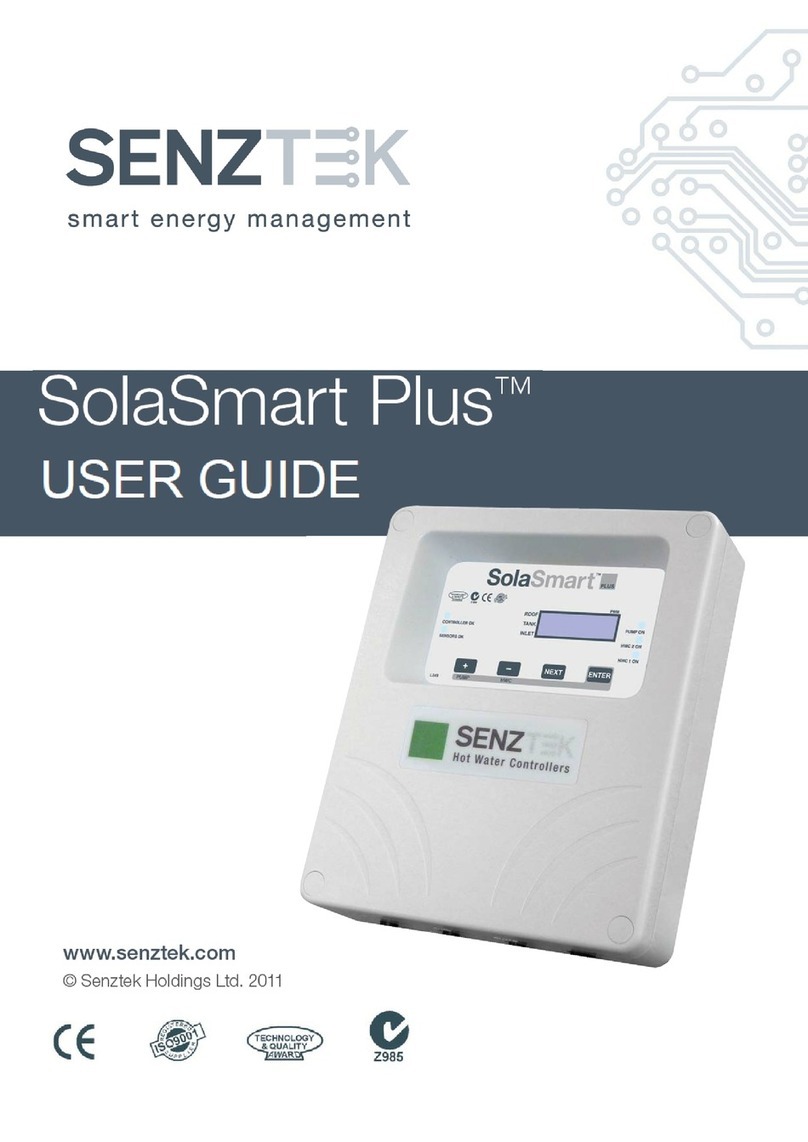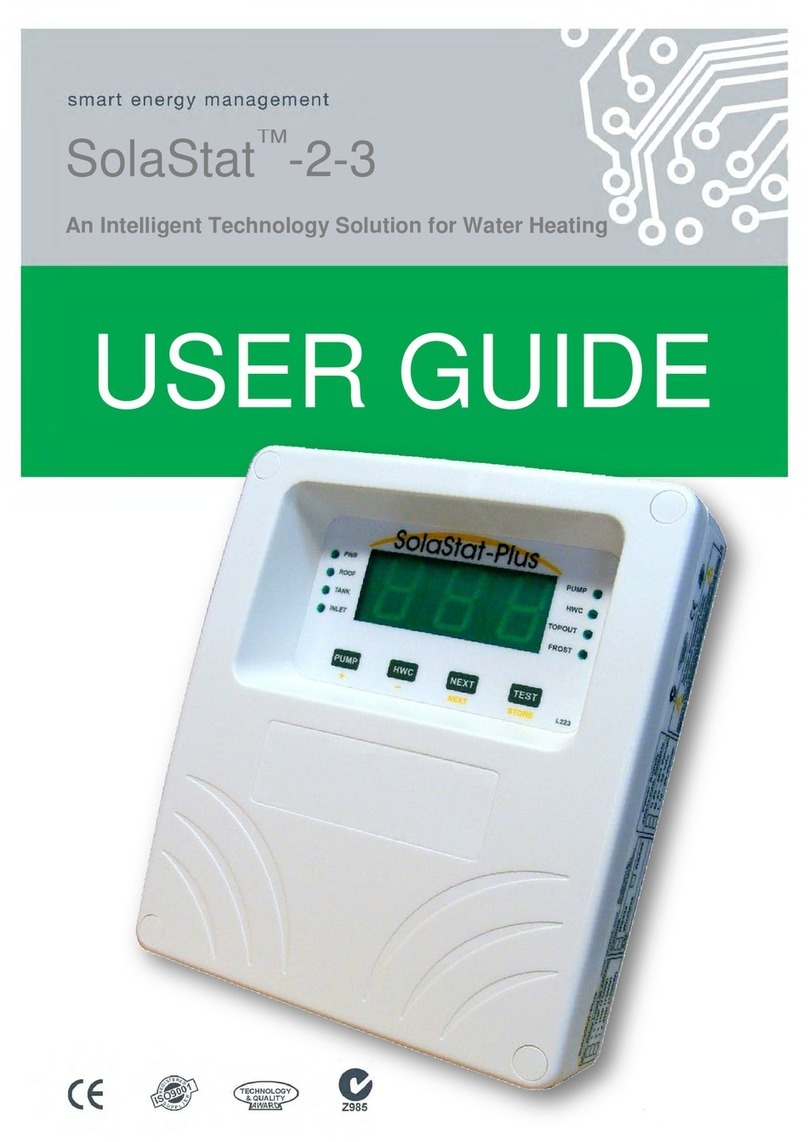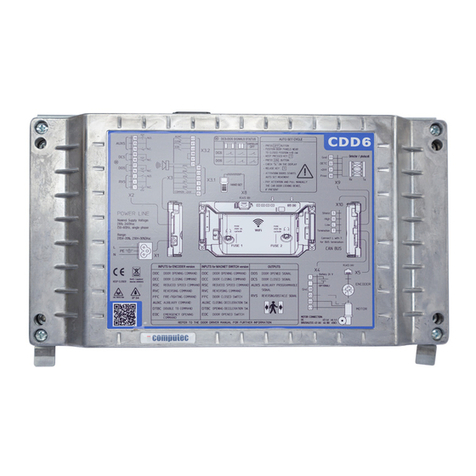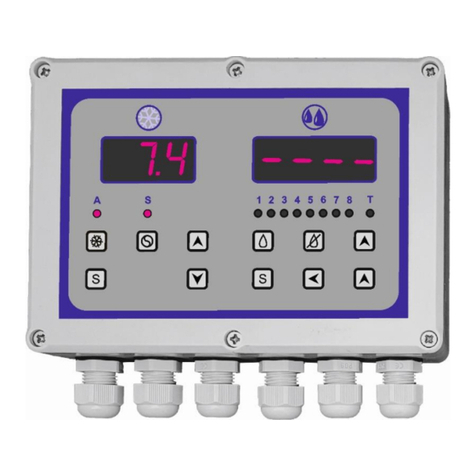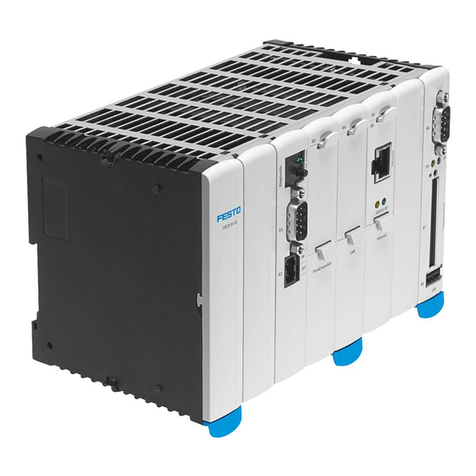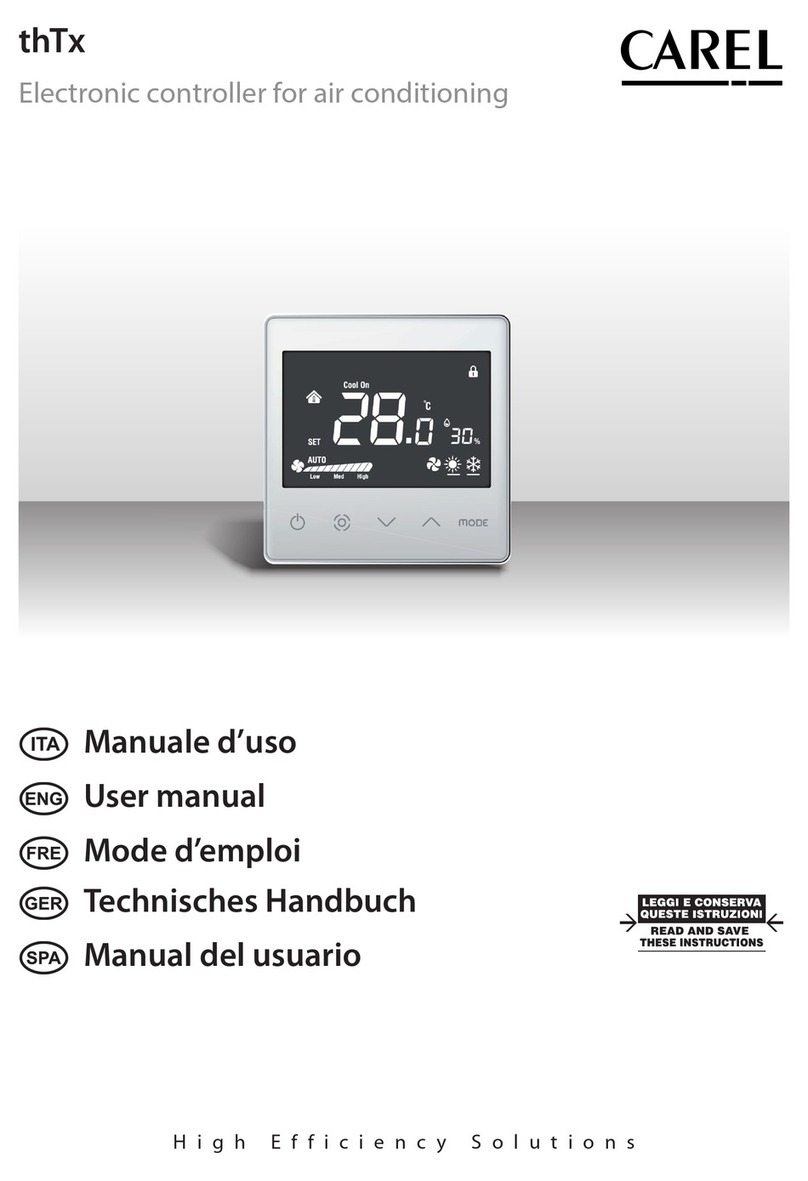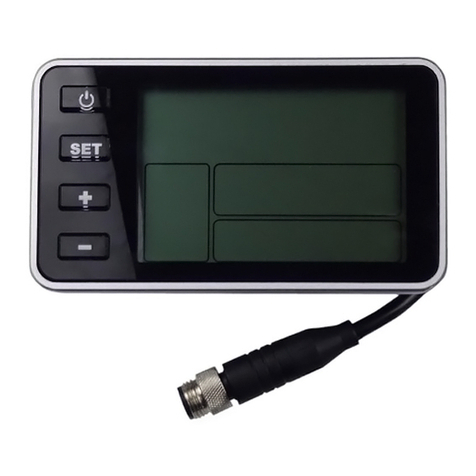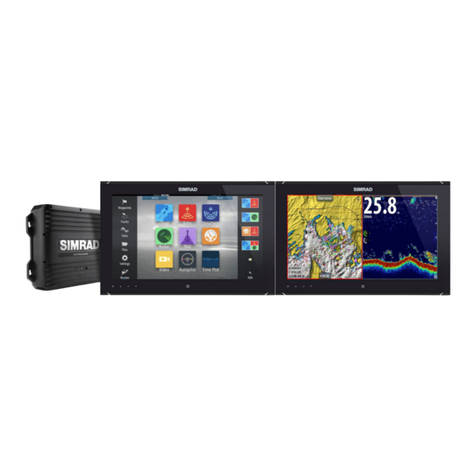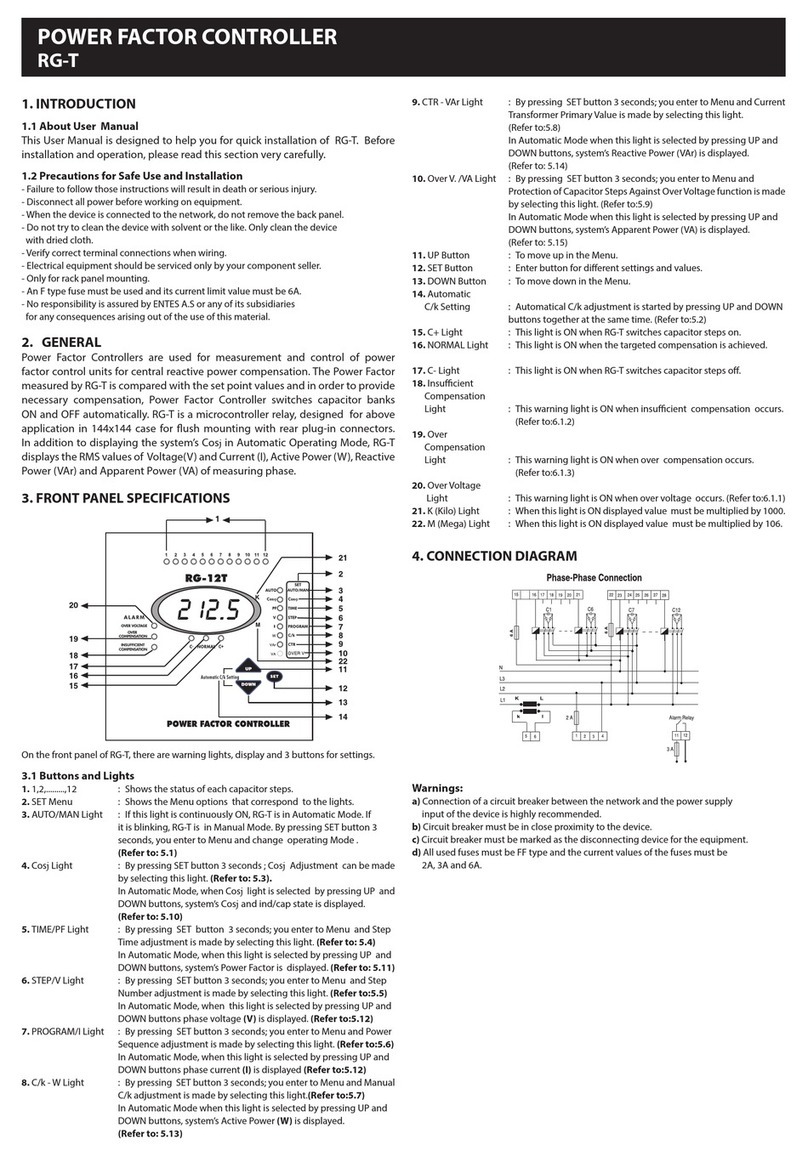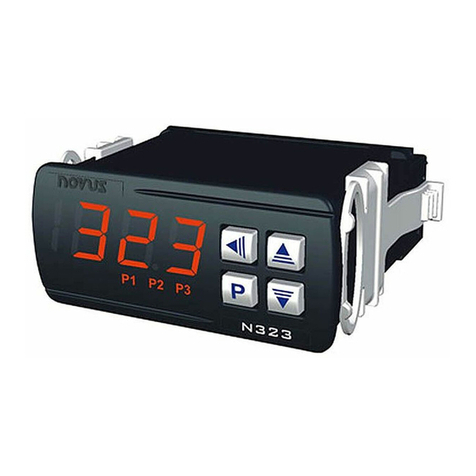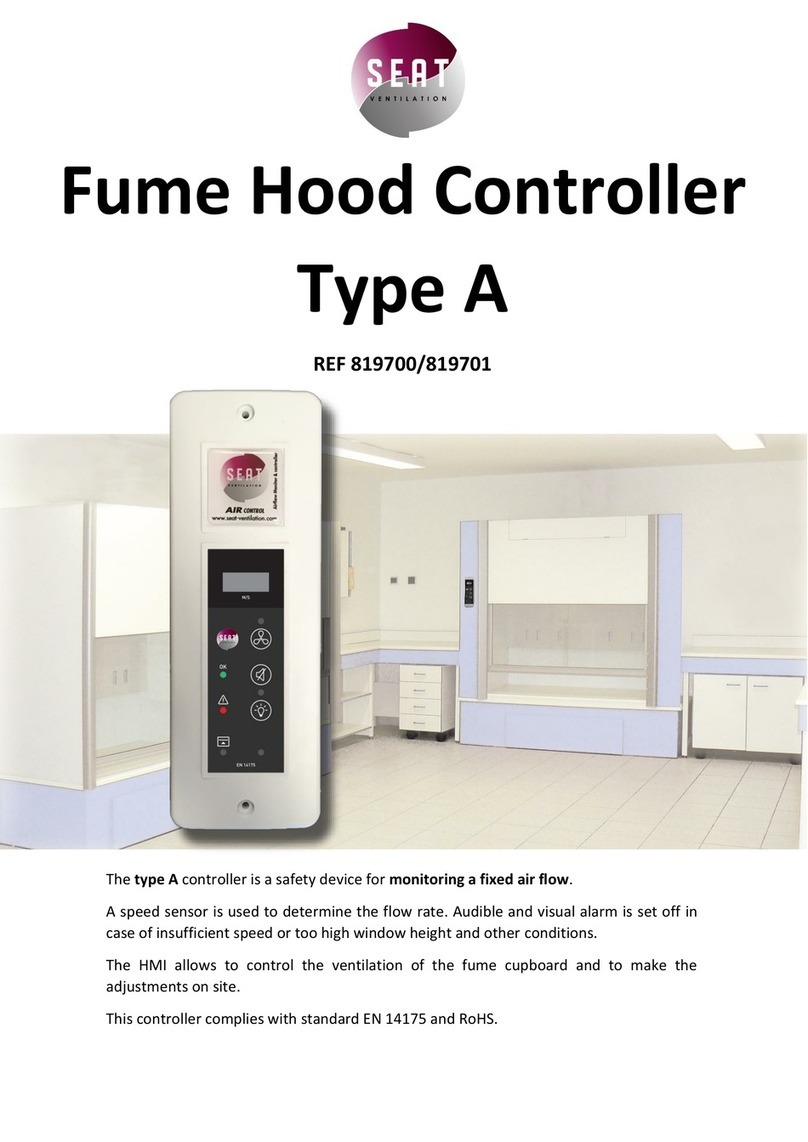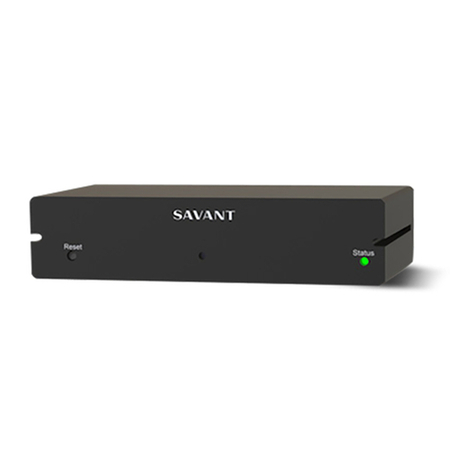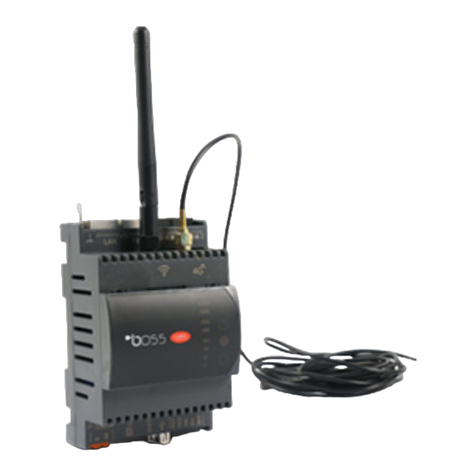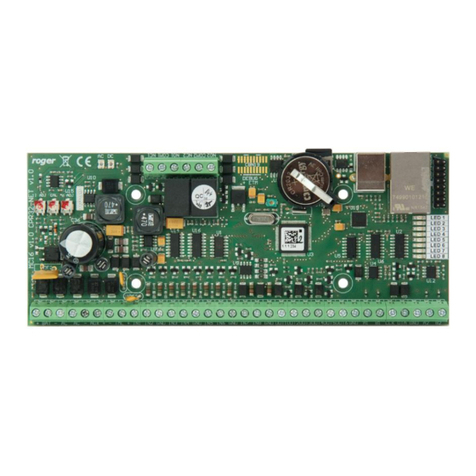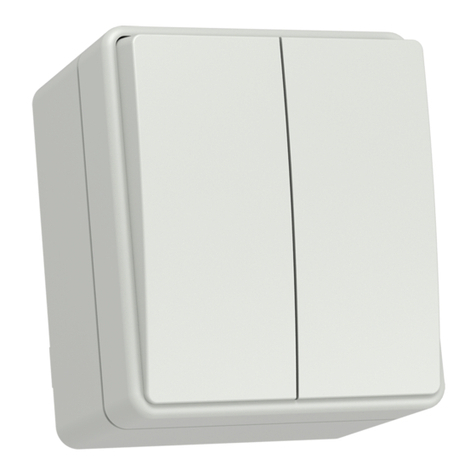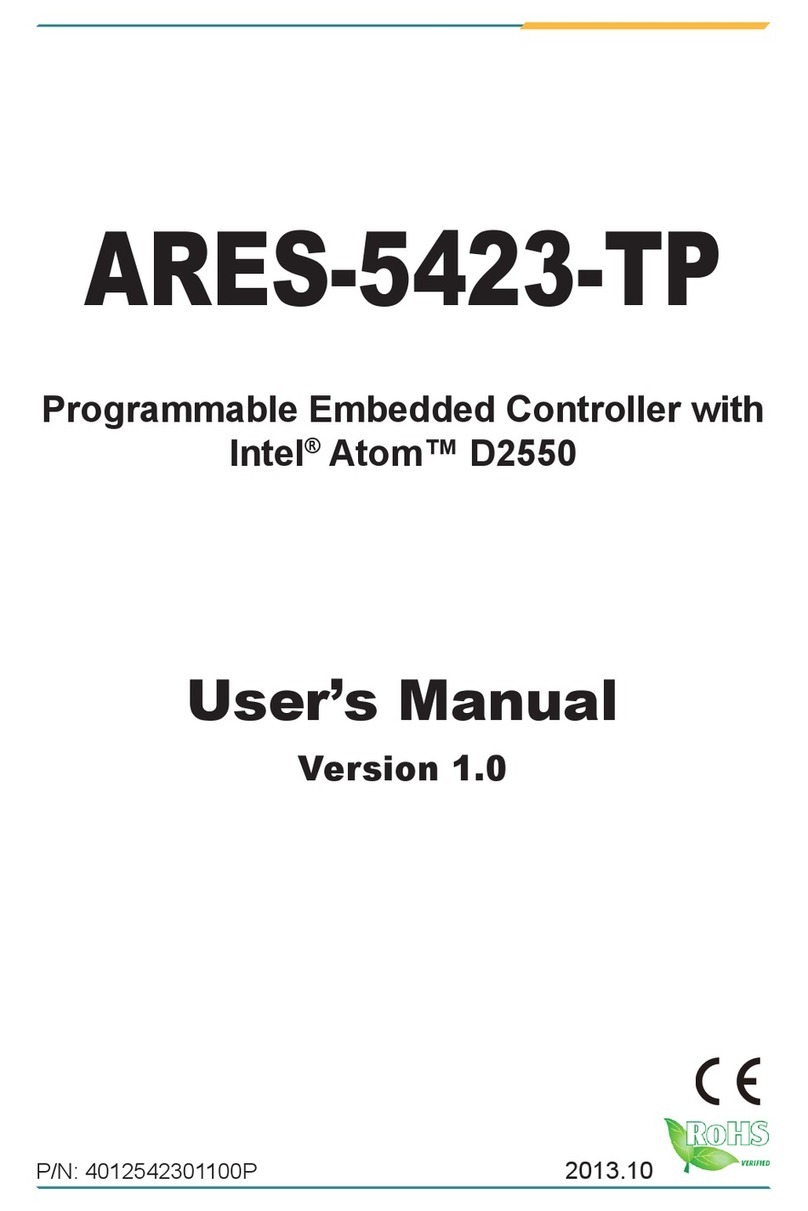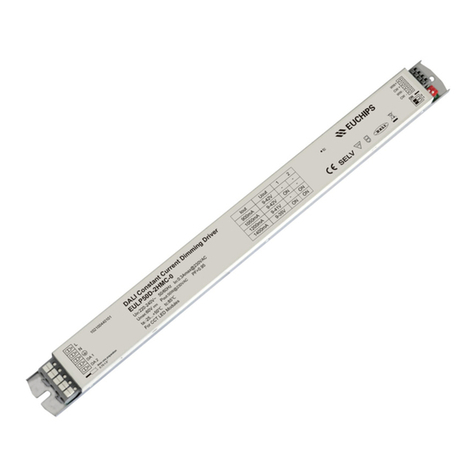Senztek SolaStat-ST User manual

SolaStatTM
-ST
An Intelligent Technology Solution for Water Heating
INSTALLATION GuIde
FOR QUALIFIED PERSONNEL ONLY


SolaStat™-ST Installation Guide
Version 1.4 – March 2009 Table of Contents
Table of Contents
Before You Begin Installation...........................................................................1
Installing the SolaStat™ Controller..................................................................5
Mounting the Sensors and Connecting Wiring.................................................7
Powering Up ..................................................................................................10
Plumbing Tips................................................................................................13
About the Pump Settings...............................................................................16
Holdoff, Reheat and BioSafe Functions.........................................................18
Programming the SolaStat™ .........................................................................21
Sensor Maintenance......................................................................................32
Trouble Shooting Guide.................................................................................34
Programming Table .......................................................................................36
Specifications.................................................................................................37
For technical help contact your distributor.
Distributor Details:
www.senztek.com
Senztek Holdings Ltd. 2009

SolaStat™- ST Installation Guide
Version 1.4 – March 2009 Page 1
BEFORE YOU BEGIN INSTALLATION
Assemble the
components
you will need
The SolaStat™ Controller is supplied with the following components:
Roof sensor
Tank sensor
Inlet sensor
Mains Cable
Pump Cable
Associated screws
Mounting guide
Screw covers
Continued on next page

SolaStat™- ST Installation Guide
Version 1.4 – March 2009 Page 2
BEFORE YOU BEGIN INSTALLATION,CONTINUED
Assemble the
tools you will
need
You will need the following tools to install the SolaStat™:
Philips1 screwdriver for lid screws
Pozi 2 screwdriver for mounting screws
Note: These tools are needed to mount the SolaStat™ only, and other tools
may be needed for the remainder of the installation including the sensors.
READ THESE SAFETY PRECAUTIONS and LIMIT OF LIABILITY BEFORE YOU
BEGIN
The following pages contain instructions for qualified personnel only. They involve
potentially hazardous adjustments and high voltage mains wiring information.
General
Safety
Precautions:
The following general safety precautions should be noted:
This installation guide is for the installation of SolaStatTM Controllers only and
is not an installation guide for any other part.
The complete installation should be checked at least annually for damage
or malfunction.
All servicing must be carried out by an authorised service agent only.
All aspects of the installation must comply with local electrical and
plumbing regulations (and any special solar hot water regulations).
Continued on next page

SolaStat™- ST Installation Guide
Version 1.4 – March 2009 Page 3
BEFORE YOU BEGIN INSTALLATION,CONTINUED
Installation
Precautions: Installers need to ensure the following:
The Controller must be installed away from water sources such as rain,
leaking pipes, or wet floors and must not be installed in damp areas like
bathrooms.
Make sure the Controller is installed away from direct sunlight, flammable
liquids or radiant heat sources.
Power leads must face directly down, not sideways or upwards.
Ensure the Controller is in a safe environment for users to inspect display
panel.
Follow instructions carefully when mounting sensors. Incorrect sensor
mounting can lead to a poorly controlled solar hot water system with
safety issues (e.g. overheating; over pressure damage to the plumbing;
freezing damage to the solar collector).
The unit settings are factory programmed to optimise efficiency and
safety. Alteration of the programmed values can lead to dangerous
conditions and/ or damage to parts of the solar hot water system.
CAUTION:
Dangerous Voltages may be present. The SolaStatTM has no user
serviceable parts.
Protective enclosure must only be opened by qualified personnel.
Remove ALL power sources before removing protective cover.
Continued on next page

SolaStat™- ST Installation Guide
Version 1.4 – March 2009 Page 4
BEFORE YOU BEGIN INSTALLATION,CONTINUED
Electrical
Precautions: When undertaking electrical installations, please note the following
All mains voltage electrical work must be carried out by a qualified
electrician, especially external power outlet socket installation.
A readily accessible disconnect device, overcurrent device and RCD
Protection rated to suit the size of the pump plus 5VA must be
incorporated in the power supply wiring. The overcurrent device for a
1500W, 240Vac pump must not exceed 10Amps.
Sensor leads should be kept 300mm (12 inches) away from mains and
comms cables.
Do not use mains power extension cords unless approved by the
manufacturer. Water resistant plugs and sockets should be used.
The SolaStat™ controlled outputs (PUMP and HWC) will be connected to
the input power supply wiring and are not isolated from it. Supply
voltages will be output through that outlet during activation.
Always use the unit within specified voltage and load ranges. Never use
with damaged leads, plugs or sockets.
Do not allow the sensor cable to come within 10mm of the high voltage
connectors or components inside the enclosure.
Comply with all local and relevant electrical regulations.
Warning These products are not designed for use in, and should not be used for,
applications which are in conjunction with items that are critical to any
person’s health (e.g. life support systems).
In any critical installation, an independent fail-safe back-up system must
always be implemented.

SolaStat™- ST Installation Guide
Version 1.4 – March 2009 Page 5
INSTALLING THE SOLASTAT™CONTROLLER
Overview The diagram below shows how the SolaStat™ is connected to the Hot Water
Cylinder (HWC), the collector, and the three sensors (ROOF, TANK and
INLET).
Continued on next page

SolaStat™- ST Installation Guide
Version 1.4 – March 2009 Page 6
INSTALLING THE SOLASTAT™CONTROLLER,CONTINUED
Where to
mount the
SolaStatTM
The SolaStatTM should be mounted so that:
1. It is against a flat surface with sufficient strength to hold the enclosure
and any additional weight from the plugs, sockets and cables,
2. Power Leads face down not sideways or up.
3. It is safe for users to inspect,
4. The display can be easily read and buttons accessed, and
5. Allowance is made for cable runs, location of power outlets and lengths
of wires.
Mounting the
SolaStatTM Note: In general, you should not need to open the Controller unit during
installation unless the installation is for a Hot Water Cylinder with two
elements.
Follow these steps:
1. Allow for the enclosure dropping 5 mm (1/5 inch) from screw centres
once mounted (keyhole mounting).
2. Place the drill guide template against wall, checking for level alignment.
Four screws are supplied: two chipboard screws and two combination
plasterboard/ wood screws.
All four mounting holes should be used with at least two firmly secured
into wood.
The outer plastic plasterboard anchors will self tap into plasterboard and
their inner metal screws fix into the centre of the plastic anchors.
3. Mark and drill/ screw as appropriate leaving the heads of the screws
above the surface by approximately 3 mm (1/8 inch).
4. Place the unit over the four screw heads. The unit should slide down
5mm into the ‘key’ slots and become secured to the wall. You will need to
adjust the screw height to obtain a secure fit.

SolaStat™- ST Installation Guide
Version 1.4 – March 2009 Page 7
MOUNTING THE SENSORS AND CONNECTING WIRING
Introduction The locations and way that the sensors are mounted is critical to ensure the
SolaStat™ -
operates correctly and at greatest efficiency;
protects the system against damage from extreme temperatures, and
displays hot water readings are accurately.
If the TANK and/ or INLET sensors are not mounted correctly –
There may be inaccurate Topout sensing, which could lead to damage to
the Hot water cylinder or other components
There may be inaccurate BioSafe sensing, which could increase the risk
of biological contamination
Hot water readings on the display may be inaccurate
If the ROOF sensors are not correctly mounted –
The unit may not be able to detect FROST settings (this can lead to the
collector panel bursting)
Please follow the instructions below carefully.
Positioning
the ROOF
Sensor
The ROOF Sensor should be fitted into a metal immersion ‘pocket’ just inside
solar collector in the hot water outlet pipe.
Apply plenty of heat transfer compound (available from your distributor)
between the sensor and the lining of the hot water outlet pipe.
Seal the sensor with neutral cure sealant and install external lagging. The
cable should also be insulated from the bare pipe.
Positioning
the TANK
Sensor
The TANK Sensor should be fitted into a metal immersion ‘pocket’ in the
upper region of the Hot Water Cylinder (HWC) (typically 1/3 of the way down
from the top of the HWC, or the first possible place below 1/3 of the way
down.
If a ‘pocket’ is not available, then bond the sensor against the metal wall of
the tank (not the outside cladding or insulation).
Apply plenty of heat transfer compound (available from your distributor)
between the sensor and the lining of the ‘pocket’ (or between the tank and
the sensor).
Continued on next page

SolaStat™- ST Installation Guide
Version 1.4 – March 2009 Page 8
MOUNTING THE SENSORS AND CONNECTING WIRING,CONTINUED
Positioning
the Inlet
Sensor
The INLET Sensor should be fitted into a metal immersion ‘pocket’ above the
HWC electric element near the bottom of the tank (usually just above the
element).
If a ‘pocket’ is not available, then bond the sensor against the metal wall of
the tank (not the outside cladding or insulation).
Apply plenty of heat transfer compound (available from your distributor)
between the sensor and the lining of the ‘pocket’. (or between the tank and
the sensor).
Precautions Please note:
Removing or cutting the cladding may void the hot water tank warranty.
The sensor must not be immersed in water.
Sensor leads should be kept 300mm (12inches) away from mains and
communications cables.
Make sure the right sensors are mounted in the right places!
Continued on next page

SolaStat™- ST Installation Guide
Version 1.4 – March 2009 Page 9
MOUNTING THE SENSORS AND CONNECTING WIRING,CONTINUED
Connect the
Wiring The SolaStat™ is normally supplied pre-wired, hence wiring inside the
controller should not be necessary.
However, if needed, the wiring diagrams below show you how to wire the unit
for single and dual elements.
1. Connect the wiring from the Controller to the ROOF sensor, the TANK
Sensor and the INLET sensor.
2. Connect the mains wiring;
3. Connect the wiring for the Hot water cylinder element.
The unit can also be installed with the wiring entering from behind the unit.
For permanently wired units, see the separate sheet for instructions.
2. Connect the
wiring from the
controller to the
ROOF sensor,
the TANK Sensor
and the INLET
Sensor (as
labeled
)
1. Connect the
Mains wiring
3. Connect the wiring from the
controller to the Hot Water
Cylinder Element
4. Connect the Pump wiring. Make
sure the pump is appropriate for
domestic hot water circulation and
does not exceed 1 Horsepower
rating as shown on the label on the
side of the enclosure.

SolaStat™- ST Installation Guide
Version 1.4 – March 2009 Page 10
POWERING UP
Before you
Connect the
Power
Before you power up, make sure you have
Read the safety instructions, warnings and liability statements,
Completed installation, and
Securely mounted the unit in place before you connect power to the unit.
Checked that no water, metal shavings or other electrical hazards are
anywhere near the plug, socket and/ or surrounding environment
Notes:
The Power outlet socket must be installed by a registered electrician
The SolaStat™ must be installed by a qualified person
Ensure suitable over-current protection and RCD Protection for the
SolaStat™ is in place.
The mechanical Hot Water Thermostat for the Electric Element should be
set to the maximum for the HWC Control Modes to operate correctly.
(The Hot Water Thermostat is only used as a fail safe feature and
normally will not operate.)
Continued on next page

SolaStat™- ST Installation Guide
Version 1.4 – March 2009 Page 11
POWERING UP,CONTINUED
What you will
see When you power up the unit, it will look like the picture below.
Check that the PUMP is operating by pressing the PUMP button. This will
turn the pump on for as long as you hold it down, unless it is already
operating
A digital readout of the TANK temperature.
Note: This temperature reading will be the outside
surface temperature of the tank.
It may be a couple of degrees lower than the water
temperature in the tank, especially on glass lined
ceramic tanks.
These lights will show you if the pump is working or (as shown here)
and/ or the hot water cylinder element /s is/ are heating up.
The TANK light should be on –
showing the sensor
measurement that is on the
screen
Check that the PUMP is operating by
pressing the PUMP button. This will turn the
pump on for as long as you hold it down,
unless it is already operating.

SolaStat™- ST Installation Guide
Version 1.4 – March 2009 Page 12
POWERING UP,CONTINUED
Note When the SolaStatTM is turned on for the first time, BioSafe will be turned on
for an hour, if both TANK and INLET temperatures are higher than BioSafe
Temperature.
The unit will continue to monitor the hot water tank.
If the TANK or INLET temperature is below the BioSafe temperature for
about 72 hours, BioSafe will be activated again. This will heat the tank to the
BioSafe temperature.
The Holdoff timer will start from the next time the pump is activated.
Final Checks The SolaStatTM is now fully installed and should be working.
It is best to observe some solar hot water pump cycles, but this will depend
on the sun shining.
Check all functions are working correctly before leaving the installation.
The SolaStat™ settings have been factory set to the standard settings for
your area and requirements.
These can be adjusted by a certified installer, using the instructions in the
‘Programming the SolaStat™’ section on pages 21- 31 in this manual.
See ‘Trouble Shooting’ section on page 34 of this guide if the system is not
working correctly.

SolaStat™- ST Installation Guide
Version 1.4 – March 2009 Page 13
PLUMBING TIPS
Overview This section will help you to ensure the plumbing associated with the
SolaStat™ will enable the system to be operated safety and to maximum
efficiency.
All plumbing installations should be carried out by registered and qualified
plumber; and all regulatory and local standards must be applied. Best
plumbing standards must be used for all plumbing work associated with
installation and maintenance.
All parts including the pump must be rated for the elevated temperatures
found in solar hot water systems.
The information provided here provides feedback from experienced solar hot
water professionals, but does not represent a complete guide to plumbing a
system.
Tempering
Valve Water from solar hot water collectors frequently reaches very high
temperatures. It may exceed 100°C / 212°F (under pressure).
A tempering (or mixing) valve must be installed if required by local
regulations.
It is used to ensure the supply from the tank does not burn end users. The
tempering valve must be appropriately rated to handle extreme
temperatures.
Installation must be to best plumbing practice and the manufacturer’s
specifications.
Non return
valve Hot water rises and cold water falls. If the solar collector is colder than the
tank (e.g. at night) the hot water from the tank can thermo-siphon up to the
collector. The collector then radiates the heat to the cool night air and the
cooler water descends back to the tank.
To stop this loss of hot water at night or during cloudy skies, a ‘one way’ or
non-return valve needs to be fitted.
The failure of this non-return valve is a common problem with solar hot water
systems. Some key points are:
It is critical to make sure that the orientation of the valve is as per the
manufacturer’s directions.
Make sure there are no debris caught in the valve as that could cause the
valve not to close.
Continued on next page

SolaStat™- ST Installation Guide
Version 1.4 – March 2009 Page 14
PLUMBING TIPS,CONTINUED
Pressure
Relief Valves Solar hot water systems can run much hotter than standard domestic hot
water systems. Hotter water expands more, and needs high quality pressure
relief valves to ensure the tank or other components do not burst under
pressure.
A qualified plumber can recommend the best practice solution for each
installation for pressure relief valves, including the number and placement of
them.
Air Relief
Valves Air locks can occur within the piping system (as well as the pump). These
can increase the pressure that the pump is working against, to the point
where the pump can no longer circulate the water.
To avoid this, air relief valves should be fitted (especially in low pressure
systems).
Your registered plumber should install the air relief valves to the highest point
of both the feed to, and the return from, the solar water collector.
About Pump
Cavitation If the water pressure drops and/ or the temperature of water being pumped
rises, cavitation can occur at the pump. This is especially likely in low
pressure systems.
Bubbles form when the water is sucked into the pump’s impellor; and they
collapse again when the water is ejected out of the impellor.
This can make a rumbling/ cracking noise (like stones are passing through
the pump). It can cause damage to the impellor and other sensitive
components; and it also results in less volume of water being moved.
Your SolaStat™ has an automatic timer setting, which can help to minimise
cavitation.
The timer is normally factory set to switch off the pump after every 10
minutes operation, for a period of one minute. This helps any accumulated
air to escape from the pump.
This feature can also help prevent the pump from running for extended
periods in a ‘locked up’ state.
Continued on next page

SolaStat™- ST Installation Guide
Version 1.4 – March 2009 Page 15
PLUMBING TIPS,CONTINUED
Pump
Cavitation To prevent cavitation:
Make sure the pump is appropriate for the installation
On a variable speed pump, make sure the setting is correct – a slower
speed that still has enough head pressure is best, as it will minimise the
pressure difference at the pump.
Mount the pump as low as possible relative to the tank, so the water
pressure from the tank feeding in to the pump is maximised.
Lower the resistance to water flow to the pump (use wider – at least ½ “
diameter pipes; reduce the number and ‘sharpness’ of s-bends, etc)
If cavitation at the pump remains a problem, you may need to consider:
Installing a larger pump with a larger impellor to reduce the vacuum at the
impellor
Converting the system to mains pressure

SolaStat™- ST Installation Guide
Version 1.4 – March 2009 Page 16
ABOUT THE PUMP SETTINGS
Introduction The SolaStat™ works by turning the pump when the difference between the
temperature at the solar hot water Collector (ROOF) and the INLET is at a
certain level.
The pump turns on when the difference between these two temperatures is
high (i.e. the temperature at the solar hot water Collector is significantly
higher than the temperature at the bottom of the tank (INLET).
The pump turns off again when the difference gets less (i.e. the water in the
tank has been heated up.
For example, using the standard settings:
PUMP ON = 12°C / 21°F and PUMP OFF = 6°C / 10°F:
When the solar hot water collector (ROOF) water temperature is 12°C /
21°F higher than the TANK, the pump turns on. This transfers hot water
from the collector to the tank, and transfers cooler water from the bottom
of the tank to the collector.
This makes the temperature in the Tank heat up; and the temperature in
the Collector on the ROOF cool down.
When the difference in the two temperatures reduces to 6°C / 10°F, the
pump switches off, allowing the water in the collector to heat up again.
About the
setting:
For standard domestic hot water systems, the recommended settings are
relatively large (e.g. PUMP ON = 12°C / 21°F and PUMP OFF = 6°C / 10°F.
This causes the pump to transfer hotter water over shorter periods of time.
For lower temperature systems (like swimming pools or under-floor
heating), these temperatures settings should be set lower (e.g. PUMP ON =
5°C / 9°F and PUMP OFF = 2°C / 3°F).
This causes the pump to transfer more water at lower temperatures.
Continued on next page

SolaStat™- ST Installation Guide
Version 1.4 – March 2009 Page 17
ABOUT THE PUMP SETTINGS,CONTINUED
Adjusting the
Setting If you increase the PUMP ON value, the solar heater will heat up more
before the heat is transferred to your hot water tank.
Hotter water will enter your tank, but it may take longer to heat the water to
that level; or on dull days, the temperature difference will not be enough to
activate the pump (and the energy in the water within the collector will be
lost).
If you increase the PUMP OFF value, then the difference in the temperature
of the water coming from the solar collector compared with the tank is greater
when the pump turns off (the water entering the tank will be hotter than the
water already in the tank).
This will reduce heat losses in pipes, but less energy may be transferred.
Table of contents
Other Senztek Controllers manuals
